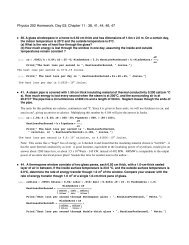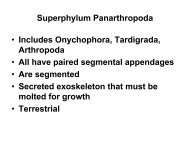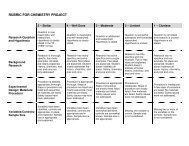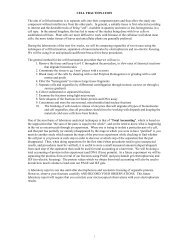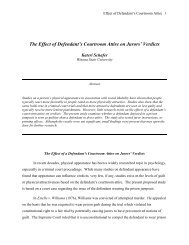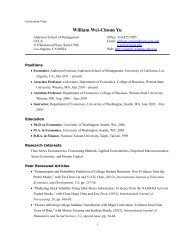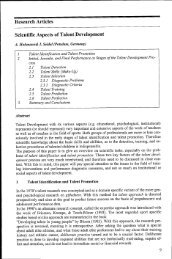The Effectiveness of Interrogations on Psychopaths - Winona State ...
The Effectiveness of Interrogations on Psychopaths - Winona State ...
The Effectiveness of Interrogations on Psychopaths - Winona State ...
Create successful ePaper yourself
Turn your PDF publications into a flip-book with our unique Google optimized e-Paper software.
<str<strong>on</strong>g>The</str<strong>on</strong>g> <str<strong>on</strong>g>Effectiveness</str<strong>on</strong>g> <str<strong>on</strong>g>of</str<strong>on</strong>g> <str<strong>on</strong>g>Interrogati<strong>on</strong>s</str<strong>on</strong>g> <strong>on</strong> <strong>Psychopaths</strong> 1<br />
<str<strong>on</strong>g>The</str<strong>on</strong>g> <str<strong>on</strong>g>Effectiveness</str<strong>on</strong>g> <str<strong>on</strong>g>of</str<strong>on</strong>g> <str<strong>on</strong>g>Interrogati<strong>on</strong>s</str<strong>on</strong>g> <strong>on</strong> <strong>Psychopaths</strong><br />
<str<strong>on</strong>g>The</str<strong>on</strong>g> <str<strong>on</strong>g>Effectiveness</str<strong>on</strong>g> <str<strong>on</strong>g>of</str<strong>on</strong>g> <str<strong>on</strong>g>Interrogati<strong>on</strong>s</str<strong>on</strong>g> <strong>on</strong><br />
<strong>Psychopaths</strong><br />
“<strong>Psychopaths</strong> are resp<strong>on</strong>sible for more than 50<br />
percent <str<strong>on</strong>g>of</str<strong>on</strong>g> the serious crime committed” and “[o]n<br />
average, about 20 percent <str<strong>on</strong>g>of</str<strong>on</strong>g> the male and female<br />
pris<strong>on</strong> inmates are psychopaths (Hare, 1993).” In<br />
light <str<strong>on</strong>g>of</str<strong>on</strong>g> the previous statements, I find it hard to<br />
believe that there is not more <str<strong>on</strong>g>of</str<strong>on</strong>g> an emphasis <strong>on</strong><br />
psychopathy during legal procedures. <str<strong>on</strong>g>The</str<strong>on</strong>g>re has<br />
been research d<strong>on</strong>e <strong>on</strong> the aggressi<strong>on</strong> <str<strong>on</strong>g>of</str<strong>on</strong>g><br />
psychopaths in pris<strong>on</strong> (Dolan, 2003), as well as<br />
the recidivism rates <str<strong>on</strong>g>of</str<strong>on</strong>g> psychopaths (Langstrom &<br />
Grann, 2002; Sjostedt & Langstrom, 2002; Grann,<br />
Langstrom, Tengstrom & Kullgren, 1999). <str<strong>on</strong>g>The</str<strong>on</strong>g>re<br />
has not been any research <strong>on</strong> the effectiveness <str<strong>on</strong>g>of</str<strong>on</strong>g><br />
interrogati<strong>on</strong> procedures when dealing with<br />
psychopaths. I believe that we need to assess the<br />
effectiveness <str<strong>on</strong>g>of</str<strong>on</strong>g> current interrogati<strong>on</strong> procedures<br />
in eliciting c<strong>on</strong>fessi<strong>on</strong>s from psychopaths. I also<br />
think that we need to look at the different ways in<br />
which interrogators assess guilt during<br />
interrogati<strong>on</strong>s, and the effectiveness <str<strong>on</strong>g>of</str<strong>on</strong>g> these<br />
methods <strong>on</strong> psychopaths. In the following paper,<br />
I will discuss some background informati<strong>on</strong> <strong>on</strong><br />
psychopathy. <str<strong>on</strong>g>The</str<strong>on</strong>g>n, I will explain the<br />
interrogati<strong>on</strong> procedure as it relates to<br />
psychopathy. I will then examine the<br />
effectiveness <str<strong>on</strong>g>of</str<strong>on</strong>g> certain interrogati<strong>on</strong> procedures<br />
in eliciting c<strong>on</strong>fessi<strong>on</strong>s. Following this, I will<br />
show the problems in the techniques used to<br />
assess the guilt <str<strong>on</strong>g>of</str<strong>on</strong>g> a psychopath, by the<br />
interrogative, scientific and psychological<br />
perspectives. In order to answer the two main<br />
questi<strong>on</strong>s in the paper, I will propose two research<br />
studies. One study will be dealing with the<br />
Steven Helseth<br />
Win<strong>on</strong>a <strong>State</strong> University<br />
effectiveness <str<strong>on</strong>g>of</str<strong>on</strong>g> current interrogati<strong>on</strong> techniques<br />
<strong>on</strong> eliciting c<strong>on</strong>fessi<strong>on</strong>s from psychopaths. <str<strong>on</strong>g>The</str<strong>on</strong>g><br />
other study will examine methods <str<strong>on</strong>g>of</str<strong>on</strong>g> assessing<br />
guilt when dealing with psychopaths.<br />
One <str<strong>on</strong>g>of</str<strong>on</strong>g> the most recognized authorities <strong>on</strong><br />
psychopathy is Dr. Robert Hare. Dr. Hare,<br />
al<strong>on</strong>g with his colleagues, developed the<br />
Psychopathy Checklist, followed by the<br />
Psychopathy Checklist Revised, known as the<br />
PCLR. <str<strong>on</strong>g>The</str<strong>on</strong>g> PCLR is recognized as <strong>on</strong>e <str<strong>on</strong>g>of</str<strong>on</strong>g> the<br />
best instruments for measuring psychopathy, as<br />
well as <strong>on</strong>e <str<strong>on</strong>g>of</str<strong>on</strong>g> the most effective (Fulero, 1995;<br />
St<strong>on</strong>e, 1995 in Grann, 1999). <str<strong>on</strong>g>The</str<strong>on</strong>g> PCLR is<br />
broken down into two separate factors (Hare,<br />
1991; Hare et al., 1990; Harper, Hare, &<br />
Hakstain, 1989; Templeman & W<strong>on</strong>g, 1994 in<br />
Grann, 1999). <str<strong>on</strong>g>The</str<strong>on</strong>g> first factor is composed <str<strong>on</strong>g>of</str<strong>on</strong>g><br />
emoti<strong>on</strong>al or interpers<strong>on</strong>al traits (Hare, 1993).<br />
<str<strong>on</strong>g>The</str<strong>on</strong>g>se traits include being superficial,<br />
egocentric, remorseless, deceitful, manipulative,<br />
and emoti<strong>on</strong>ally shallow. <str<strong>on</strong>g>The</str<strong>on</strong>g> sec<strong>on</strong>d factor is<br />
composed <str<strong>on</strong>g>of</str<strong>on</strong>g> behavioral traits relating to social<br />
deviance. <str<strong>on</strong>g>The</str<strong>on</strong>g>se traits include being impulsive,<br />
exhibiting poor behavioral c<strong>on</strong>trols, needing<br />
excitement, lacking resp<strong>on</strong>sibility, having early<br />
behavioral problems, and exhibiting adult<br />
antisocial behavior. Some <str<strong>on</strong>g>of</str<strong>on</strong>g> the<br />
emoti<strong>on</strong>al/interpers<strong>on</strong>al traits that I find to be<br />
especially important to the interrogative<br />
procedure are being glib and superficial, being<br />
egocentric and grandiose, being deceitful and<br />
manipulative, and having shallow emoti<strong>on</strong>s.<br />
Referring to psychopaths being glib and<br />
superficial, they are skilled at making<br />
themselves look good. <str<strong>on</strong>g>The</str<strong>on</strong>g>y may make<br />
themselves out to be an expert <strong>on</strong> topics that<br />
they really are not. This trait makes them good<br />
WSU Psychology Student Journal, Issue A Steven Helseth
<str<strong>on</strong>g>The</str<strong>on</strong>g> <str<strong>on</strong>g>Effectiveness</str<strong>on</strong>g> <str<strong>on</strong>g>of</str<strong>on</strong>g> <str<strong>on</strong>g>Interrogati<strong>on</strong>s</str<strong>on</strong>g> <strong>on</strong> <strong>Psychopaths</strong> 2<br />
at flattering the people around them in order to<br />
take advantage <str<strong>on</strong>g>of</str<strong>on</strong>g> them (Hare, 1993). In additi<strong>on</strong>,<br />
psychopaths are very egocentric. <str<strong>on</strong>g>The</str<strong>on</strong>g>y appear<br />
very cocky in the presence <str<strong>on</strong>g>of</str<strong>on</strong>g> others. <str<strong>on</strong>g>The</str<strong>on</strong>g>y seem<br />
to have extreme c<strong>on</strong>fidence in themselves as well<br />
as in their abilities. <strong>Psychopaths</strong> are also very<br />
deceitful and manipulative. <str<strong>on</strong>g>The</str<strong>on</strong>g> inner focus <str<strong>on</strong>g>of</str<strong>on</strong>g> a<br />
psychopath makes their lying more effective.<br />
<str<strong>on</strong>g>The</str<strong>on</strong>g>y are not worried about being found out, so<br />
when c<strong>on</strong>fr<strong>on</strong>ted, they will simply adjust their<br />
story to adhere to the lie they are telling. This<br />
makes it hard to tell when you have caught a<br />
psychopath in a lie, because they will not be<br />
affected. <strong>Psychopaths</strong> also have shallow<br />
emoti<strong>on</strong>s. <str<strong>on</strong>g>The</str<strong>on</strong>g>y do not seem to experience<br />
emoti<strong>on</strong>s in the same way that most people do.<br />
<str<strong>on</strong>g>The</str<strong>on</strong>g> <strong>on</strong>e behavioral trait that I believe would hold<br />
some importance in relati<strong>on</strong> to the interrogati<strong>on</strong><br />
process is the impulsive nature <str<strong>on</strong>g>of</str<strong>on</strong>g> the psychopath.<br />
<strong>Psychopaths</strong> are very impulsive in their decisi<strong>on</strong>s.<br />
<str<strong>on</strong>g>The</str<strong>on</strong>g>y do not take the time to weigh the<br />
c<strong>on</strong>sequences <str<strong>on</strong>g>of</str<strong>on</strong>g> their acti<strong>on</strong>s and are likely to act<br />
in order to achieve immediate pleasure or to avoid<br />
something that is inc<strong>on</strong>veniencing them at the<br />
time. With a lengthy interrogati<strong>on</strong>, they may not<br />
worry about the c<strong>on</strong>sequences <str<strong>on</strong>g>of</str<strong>on</strong>g> c<strong>on</strong>fessing, as<br />
much as the inc<strong>on</strong>venience <str<strong>on</strong>g>of</str<strong>on</strong>g> being questi<strong>on</strong>ed.<br />
All <str<strong>on</strong>g>of</str<strong>on</strong>g> these traits could affect the interrogati<strong>on</strong> <str<strong>on</strong>g>of</str<strong>on</strong>g><br />
a psychopath.<br />
<str<strong>on</strong>g>The</str<strong>on</strong>g> role <str<strong>on</strong>g>of</str<strong>on</strong>g> low fearfulness in the psychopath<br />
plays into many <str<strong>on</strong>g>of</str<strong>on</strong>g> the other traits <str<strong>on</strong>g>of</str<strong>on</strong>g> a psychopath<br />
(Lykken, 1995). Lykken believes that every<br />
pers<strong>on</strong> has a different level <str<strong>on</strong>g>of</str<strong>on</strong>g> fearfulness. He<br />
calls this the pers<strong>on</strong>’s fear quotient. At <strong>on</strong>e end <str<strong>on</strong>g>of</str<strong>on</strong>g><br />
the spectrum are those people who are extremely<br />
fearful <str<strong>on</strong>g>of</str<strong>on</strong>g> relatively n<strong>on</strong>dangerous situati<strong>on</strong>s.<br />
<str<strong>on</strong>g>The</str<strong>on</strong>g>se people would be c<strong>on</strong>sidered phobic. <str<strong>on</strong>g>The</str<strong>on</strong>g>re<br />
are also people at the other end <str<strong>on</strong>g>of</str<strong>on</strong>g> the spectrum,<br />
who experience very low fear when faced with<br />
extremely dangerous situati<strong>on</strong>s. <strong>Psychopaths</strong> fall<br />
<strong>on</strong> the low fear end <str<strong>on</strong>g>of</str<strong>on</strong>g> the spectrum. Lykken<br />
believes that psychopaths may appear shallow<br />
emoti<strong>on</strong>ally, but this could be due to their low<br />
fear. Having low fear could cause them not to be<br />
angry or jealous for the same reas<strong>on</strong>s that a fearful<br />
pers<strong>on</strong> might. Lykken c<strong>on</strong>ducted a research study<br />
to test his low fear hypothesis. <str<strong>on</strong>g>The</str<strong>on</strong>g> study was<br />
designed to compare the c<strong>on</strong>diti<strong>on</strong>ed resp<strong>on</strong>ses<br />
<str<strong>on</strong>g>of</str<strong>on</strong>g> psychopaths, ordinary criminals, and normal<br />
people. <strong>Psychopaths</strong> were defined by matching<br />
Cleckley’s Criteria for a psychopath.<br />
Cleckley’s criteria lay the ground work for the<br />
PCL (Hare, 2003). <str<strong>on</strong>g>The</str<strong>on</strong>g> first stage <str<strong>on</strong>g>of</str<strong>on</strong>g> the<br />
experiment was to determine the subjects’<br />
tolerance threshold to a painful electric shock in<br />
order to make sure that the shock delivered in<br />
the sec<strong>on</strong>d stage was painful enough to<br />
c<strong>on</strong>diti<strong>on</strong> the resp<strong>on</strong>se. Electrodermal<br />
resp<strong>on</strong>ses to the shock stimulus were measured<br />
in the sec<strong>on</strong>d stage. <str<strong>on</strong>g>The</str<strong>on</strong>g> subjects were told that<br />
they would hear a buzzer or feel a shock. First<br />
the buzzer was presented without the shock.<br />
<str<strong>on</strong>g>The</str<strong>on</strong>g>n, the buzzer would sound for five sec<strong>on</strong>ds<br />
followed by a shock. <str<strong>on</strong>g>The</str<strong>on</strong>g>se buzzershock trials<br />
were d<strong>on</strong>e in order to c<strong>on</strong>diti<strong>on</strong> a resp<strong>on</strong>se to<br />
the buzzer. <str<strong>on</strong>g>The</str<strong>on</strong>g>n, the buzzer was presented<br />
again, without the shock, to examine the<br />
extincti<strong>on</strong> <str<strong>on</strong>g>of</str<strong>on</strong>g> the c<strong>on</strong>diti<strong>on</strong>ed resp<strong>on</strong>se. It was<br />
shown in the study, that psychopaths showed<br />
less <str<strong>on</strong>g>of</str<strong>on</strong>g> a c<strong>on</strong>diti<strong>on</strong>ed resp<strong>on</strong>se to the buzzer.<br />
One explanati<strong>on</strong> for this is that they are not<br />
afraid <str<strong>on</strong>g>of</str<strong>on</strong>g> the imminent shock because <str<strong>on</strong>g>of</str<strong>on</strong>g> their<br />
low fear. This helps illustrate Lykken’s low<br />
fear hypothesis. Lykken believes that<br />
psychopaths are harder to socialize because <str<strong>on</strong>g>of</str<strong>on</strong>g><br />
their low fear. Lykken explains psychopaths as<br />
being genetically different by having a hard to<br />
socialize genotype. <strong>Psychopaths</strong> can be<br />
properly socialized, but it requires extreme<br />
parental competence as well as a healthy<br />
envir<strong>on</strong>ment around them. <str<strong>on</strong>g>The</str<strong>on</strong>g> unsuccessful<br />
socializati<strong>on</strong> <str<strong>on</strong>g>of</str<strong>on</strong>g> many psychopaths causes them<br />
not to develop the same feeling <str<strong>on</strong>g>of</str<strong>on</strong>g> right and<br />
wr<strong>on</strong>g as socialized people. <str<strong>on</strong>g>The</str<strong>on</strong>g> psychopath’s<br />
low fear, as well as improper socializati<strong>on</strong>,<br />
could lead to problems in the interrogati<strong>on</strong><br />
process.<br />
Although there has not been any formal<br />
research <strong>on</strong> the topic, the world <str<strong>on</strong>g>of</str<strong>on</strong>g> interrogati<strong>on</strong><br />
is not completely naïve to psychopathy. A good<br />
porti<strong>on</strong> <str<strong>on</strong>g>of</str<strong>on</strong>g> the pris<strong>on</strong> populati<strong>on</strong> is composed <str<strong>on</strong>g>of</str<strong>on</strong>g><br />
psychopaths, meaning that many interrogators<br />
WSU Psychology Student Journal, Issue A Steven Helseth
<str<strong>on</strong>g>The</str<strong>on</strong>g> <str<strong>on</strong>g>Effectiveness</str<strong>on</strong>g> <str<strong>on</strong>g>of</str<strong>on</strong>g> <str<strong>on</strong>g>Interrogati<strong>on</strong>s</str<strong>on</strong>g> <strong>on</strong> <strong>Psychopaths</strong> 3<br />
have dealt with psychopaths before. Holmes<br />
(2002) writes in his book about the many<br />
encounters that he has had with psychopaths.<br />
When they enter the room, they try to overpower<br />
the interviewer. One <str<strong>on</strong>g>of</str<strong>on</strong>g> their main goals is<br />
dominati<strong>on</strong>. <str<strong>on</strong>g>The</str<strong>on</strong>g>y will maintain c<strong>on</strong>stant eye<br />
c<strong>on</strong>tact as well as try to run the c<strong>on</strong>versati<strong>on</strong>.<br />
Holmes says that in order to avoid being fooled by<br />
psychopaths, you should listen carefully to the<br />
lack <str<strong>on</strong>g>of</str<strong>on</strong>g> real people, names and addresses in the<br />
stories they tell. Holmes says that the best<br />
indicator <str<strong>on</strong>g>of</str<strong>on</strong>g> a psychopath is their relentlessness.<br />
<str<strong>on</strong>g>The</str<strong>on</strong>g>y will not take no for an answer and will sit<br />
there and talk for as l<strong>on</strong>g as it takes them to<br />
c<strong>on</strong>vince you <str<strong>on</strong>g>of</str<strong>on</strong>g> their story.<br />
Some interrogators, like Holmes, may think<br />
they are skilled at identifying when they are<br />
dealing with a psychopath. However, there is<br />
little menti<strong>on</strong> about psychopaths in interrogati<strong>on</strong><br />
literature, and even less informati<strong>on</strong> <strong>on</strong> how to<br />
deal with them (Hess, 1997, White, 2001, &<br />
Yeschke, 1987). <str<strong>on</strong>g>The</str<strong>on</strong>g>re have been many examples<br />
<str<strong>on</strong>g>of</str<strong>on</strong>g> people who are skilled in working with<br />
psychopaths, who have been fooled by them<br />
(Hare, 2003). Hare talked about a forensic<br />
psychologist who was fooled by some<strong>on</strong>e<br />
interviewing for a job. This pers<strong>on</strong> seemed to fit<br />
the descripti<strong>on</strong> <str<strong>on</strong>g>of</str<strong>on</strong>g> a psychopath and caught the<br />
psychologist’s attenti<strong>on</strong> because <str<strong>on</strong>g>of</str<strong>on</strong>g> his brilliance,<br />
and ideas. <str<strong>on</strong>g>The</str<strong>on</strong>g> psychologist later realized that this<br />
pers<strong>on</strong> was an imposter who was trying to scam<br />
him. <strong>Psychopaths</strong> are very good at manipulating<br />
and deceiving experts. Interrogators may not be<br />
as skilled as they think at identifying psychopaths.<br />
When it comes to assessing psychopathy, the<br />
PCLR and PCL:SV have been used in different<br />
areas where the law and psychopathy intersect.<br />
<str<strong>on</strong>g>The</str<strong>on</strong>g> PCL:SV is a shorter screening versi<strong>on</strong> <str<strong>on</strong>g>of</str<strong>on</strong>g> the<br />
PCLR. <str<strong>on</strong>g>The</str<strong>on</strong>g>re is a high correlati<strong>on</strong> between the<br />
PCL:SV and the PCLR (Hart et al., 1995 in<br />
Dolan & Blackburn, 2005). <str<strong>on</strong>g>The</str<strong>on</strong>g> predictive<br />
validity <str<strong>on</strong>g>of</str<strong>on</strong>g> the PCLR <strong>on</strong> violent recidivism and<br />
general recidivism has been shown significant in<br />
many studies (Langstrom, 2002; Sjostedt, 2002;<br />
Grann, 1999; Serin, 1996). One such study, by<br />
Serin (1996), was a follow up study to add to the<br />
research <strong>on</strong> the predictive validity <str<strong>on</strong>g>of</str<strong>on</strong>g> the PCLR<br />
for general and violent recidivism. <str<strong>on</strong>g>The</str<strong>on</strong>g> study<br />
looked at recidivism rates for inmates in the two<br />
years following their release from pris<strong>on</strong>. <str<strong>on</strong>g>The</str<strong>on</strong>g><br />
research found that the PCLR was a better<br />
predictor <str<strong>on</strong>g>of</str<strong>on</strong>g> violent recidivism than actuarial<br />
risk scales, or the subject’s prior history <str<strong>on</strong>g>of</str<strong>on</strong>g><br />
violent crimes. General and violent recidivism<br />
rates were higher for psychopaths than n<strong>on</strong><br />
psychopaths. <strong>Psychopaths</strong>, <strong>on</strong> average, would<br />
also fail, by committing a crime, so<strong>on</strong>er than<br />
n<strong>on</strong>psychopaths. Researches have tried to use<br />
psychopathy when predicting violence in<br />
pris<strong>on</strong>s. One study examined the behavioral<br />
infracti<strong>on</strong>s <str<strong>on</strong>g>of</str<strong>on</strong>g> subjects who had been given the<br />
PCL: SV assessment (Dolan, 2005). <str<strong>on</strong>g>The</str<strong>on</strong>g><br />
subjects were 100 male antisocial pers<strong>on</strong>ality<br />
disorder <str<strong>on</strong>g>of</str<strong>on</strong>g>fenders. <str<strong>on</strong>g>The</str<strong>on</strong>g>se subjects were given<br />
the PCL: SV and the SCID – II. Independent<br />
researchers then looked at the case files 12<br />
m<strong>on</strong>ths down the road to examine the<br />
infracti<strong>on</strong>s. <str<strong>on</strong>g>The</str<strong>on</strong>g>y found that PCL: SV scores<br />
correlated with physically aggressive and<br />
verbally aggressive infracti<strong>on</strong>s. <str<strong>on</strong>g>The</str<strong>on</strong>g> higher the<br />
inmates scored <strong>on</strong> the PCL: SV, the more<br />
infracti<strong>on</strong>s they had. <str<strong>on</strong>g>The</str<strong>on</strong>g>y also found that those<br />
who scored higher <strong>on</strong> the PCL: SV had a shorter<br />
length <str<strong>on</strong>g>of</str<strong>on</strong>g> time before the first infracti<strong>on</strong>. <str<strong>on</strong>g>The</str<strong>on</strong>g><br />
PCL: SV and the PCLR have been used in<br />
studies involving violence in pris<strong>on</strong>, as well as<br />
studies involving recidivism rates. This would<br />
provide some evidence that the PCLR could be<br />
used in research studies dealing with<br />
interrogati<strong>on</strong>s.<br />
What I have talked about relating to<br />
psychopathy is just a sliver <str<strong>on</strong>g>of</str<strong>on</strong>g> the informati<strong>on</strong><br />
and research involving it. I chose to highlight<br />
some specific parts <str<strong>on</strong>g>of</str<strong>on</strong>g> psychopathy, in order to<br />
help illustrate the importance <str<strong>on</strong>g>of</str<strong>on</strong>g> understanding<br />
psychopathy during interrogati<strong>on</strong>s.<br />
Interrogative, scientific and psychological<br />
techniques that are used in determining deceit,<br />
as well as eliciting c<strong>on</strong>fessi<strong>on</strong>s, may not be as<br />
effective for psychopaths as they are for n<strong>on</strong><br />
psychopaths.<br />
WSU Psychology Student Journal, Issue A Steven Helseth
<str<strong>on</strong>g>The</str<strong>on</strong>g> <str<strong>on</strong>g>Effectiveness</str<strong>on</strong>g> <str<strong>on</strong>g>of</str<strong>on</strong>g> <str<strong>on</strong>g>Interrogati<strong>on</strong>s</str<strong>on</strong>g> <strong>on</strong> <strong>Psychopaths</strong> 4<br />
In order to explore how interrogative<br />
techniques may be flawed when dealing with<br />
psychopaths, I will explain the interrogati<strong>on</strong><br />
process. <str<strong>on</strong>g>The</str<strong>on</strong>g> first two phases <str<strong>on</strong>g>of</str<strong>on</strong>g> the interrogati<strong>on</strong><br />
process are case analysis and n<strong>on</strong>accusatory<br />
questi<strong>on</strong>ing (Holmes, 2002). <str<strong>on</strong>g>The</str<strong>on</strong>g> case analysis is<br />
where the interrogator will gather all <str<strong>on</strong>g>of</str<strong>on</strong>g> the<br />
informati<strong>on</strong> about the suspect that they can. <str<strong>on</strong>g>The</str<strong>on</strong>g><br />
interrogator will gather general background<br />
informati<strong>on</strong>, informati<strong>on</strong> about the specific crime,<br />
and informati<strong>on</strong> about the criminal background <str<strong>on</strong>g>of</str<strong>on</strong>g><br />
the suspect. This stage is very important to make<br />
sure that there are no holes in the informati<strong>on</strong>.<br />
<str<strong>on</strong>g>The</str<strong>on</strong>g> interrogator does not want to be surprised by<br />
informati<strong>on</strong> from the pers<strong>on</strong>’s past showing up<br />
later in the interrogati<strong>on</strong>. Putting all <str<strong>on</strong>g>of</str<strong>on</strong>g> this<br />
informati<strong>on</strong> together will help the interrogator<br />
develop a theory <str<strong>on</strong>g>of</str<strong>on</strong>g> how the crime was committed<br />
in order to guide the interrogati<strong>on</strong> process.<br />
Extreme preparati<strong>on</strong> is suggested so that the<br />
interrogator can successfully move <strong>on</strong> to the next<br />
stages <str<strong>on</strong>g>of</str<strong>on</strong>g> the interrogati<strong>on</strong> process. <str<strong>on</strong>g>The</str<strong>on</strong>g> next stage<br />
<str<strong>on</strong>g>of</str<strong>on</strong>g> the interrogati<strong>on</strong> process is called n<strong>on</strong><br />
accusatory questi<strong>on</strong>ing. This is the stage where<br />
the interrogator does not accuse the suspect <str<strong>on</strong>g>of</str<strong>on</strong>g> the<br />
crime, but merely gathers informati<strong>on</strong>, directly<br />
from the suspect, and takes some physiological<br />
measurements. <str<strong>on</strong>g>The</str<strong>on</strong>g>se measures and questi<strong>on</strong>s can<br />
be used as leverage later <strong>on</strong> in the interrogati<strong>on</strong>, if<br />
it proceeds. Although they are not accusing the<br />
suspect, they will be trying to determine the guilt<br />
or the innocence <str<strong>on</strong>g>of</str<strong>on</strong>g> the suspect during this stage.<br />
<str<strong>on</strong>g>The</str<strong>on</strong>g> interrogator will be looking to see if the<br />
suspect appears defensive, hostile, n<strong>on</strong><br />
resp<strong>on</strong>sive, evasive, n<strong>on</strong>sensical, hesitant, or<br />
lacking c<strong>on</strong>fidence. I do not believe that<br />
psychopaths are as likely to appear hostile or<br />
defensive, because <str<strong>on</strong>g>of</str<strong>on</strong>g> their superficial nature.<br />
<str<strong>on</strong>g>The</str<strong>on</strong>g>y are likely to appear as if they are charming,<br />
almost to the fake extent, as opposed to hostile or<br />
defensive. In order to make certain traits like<br />
hesitati<strong>on</strong> and a lack <str<strong>on</strong>g>of</str<strong>on</strong>g> c<strong>on</strong>fidence stand out,<br />
interrogators will ask unexpected questi<strong>on</strong>s to the<br />
suspect. Many suspects will show a change in<br />
demeanor to unexpected questi<strong>on</strong>s. One point <str<strong>on</strong>g>of</str<strong>on</strong>g><br />
view <strong>on</strong> this is that the suspect feels discomfort to<br />
come up with informati<strong>on</strong> <str<strong>on</strong>g>of</str<strong>on</strong>g>f the top <str<strong>on</strong>g>of</str<strong>on</strong>g> their<br />
head (Hess, 1997). Another point <str<strong>on</strong>g>of</str<strong>on</strong>g> view deals<br />
with the complex interrelated informati<strong>on</strong> that<br />
the suspect has to process. Not <strong>on</strong>ly do they<br />
have to make up a coherent detail, but they also<br />
have to do it with the pressure <str<strong>on</strong>g>of</str<strong>on</strong>g> the<br />
interrogator bearing down <strong>on</strong> them (Holmes,<br />
2002). I believe that psychopaths may exhibit<br />
different behaviors when presented with<br />
unexpected questi<strong>on</strong>s. <strong>Psychopaths</strong> are not<br />
likely to show a lack <str<strong>on</strong>g>of</str<strong>on</strong>g> c<strong>on</strong>fidence in their story<br />
because they are very egocentric. <str<strong>on</strong>g>The</str<strong>on</strong>g>y take<br />
pride in everything they do and have very<br />
inflated views <str<strong>on</strong>g>of</str<strong>on</strong>g> themselves and do not worry<br />
about being found out. In fact, they take pride<br />
in being able to lie successfully (Hare, 2003).<br />
When <strong>on</strong>e man, scoring high <strong>on</strong> the<br />
Psychopathy Checklist, was asked if he ever<br />
lied, he resp<strong>on</strong>ded by saying, “I lie like I<br />
breathe, <strong>on</strong>e as much as the other.”(Hare, 2003)<br />
<strong>Psychopaths</strong> are less likely to hesitate because<br />
they are making up lies <strong>on</strong> a sentenceto<br />
sentence basis. <str<strong>on</strong>g>The</str<strong>on</strong>g>y do not worry about the<br />
coherence <str<strong>on</strong>g>of</str<strong>on</strong>g> the total story, or the c<strong>on</strong>sequences<br />
<str<strong>on</strong>g>of</str<strong>on</strong>g> being found out. This freedom allows them<br />
to resp<strong>on</strong>d with little to no hesitati<strong>on</strong> but this<br />
freedom could end up hurting a psychopath in<br />
the interrogati<strong>on</strong> process. <strong>Psychopaths</strong> have no<br />
worries <str<strong>on</strong>g>of</str<strong>on</strong>g> c<strong>on</strong>sistency and coherency, which<br />
causes the inc<strong>on</strong>sistencies and n<strong>on</strong>sensical<br />
nature <str<strong>on</strong>g>of</str<strong>on</strong>g> the stories they tell to appear obvious.<br />
Holmes has also realized the same<br />
inc<strong>on</strong>sistencies through his pers<strong>on</strong>al experiences<br />
dealing with psychopaths. He suggests that, as<br />
much as psychopath’s stories appear to make<br />
sense <strong>on</strong> the surface, if you listen carefully to<br />
the lack <str<strong>on</strong>g>of</str<strong>on</strong>g> real names and real places, in their<br />
stories, you can see that they do not make as<br />
much sense as they appear to. When dealing<br />
with psychopaths, an interrogators focus should<br />
shift from looking for hesitati<strong>on</strong> and a lack <str<strong>on</strong>g>of</str<strong>on</strong>g><br />
c<strong>on</strong>fidence, to the internal inc<strong>on</strong>sistencies and<br />
n<strong>on</strong>sensical nature <str<strong>on</strong>g>of</str<strong>on</strong>g> the informati<strong>on</strong> being<br />
presented.<br />
If the decisi<strong>on</strong> is made to move <strong>on</strong> to the<br />
accusatory stage <str<strong>on</strong>g>of</str<strong>on</strong>g> the interrogati<strong>on</strong>, Holmes<br />
WSU Psychology Student Journal, Issue A Steven Helseth
<str<strong>on</strong>g>The</str<strong>on</strong>g> <str<strong>on</strong>g>Effectiveness</str<strong>on</strong>g> <str<strong>on</strong>g>of</str<strong>on</strong>g> <str<strong>on</strong>g>Interrogati<strong>on</strong>s</str<strong>on</strong>g> <strong>on</strong> <strong>Psychopaths</strong> 5<br />
suggests a threestep formula for c<strong>on</strong>fessi<strong>on</strong>. <str<strong>on</strong>g>The</str<strong>on</strong>g><br />
basis <str<strong>on</strong>g>of</str<strong>on</strong>g> formula is to present evidence and then<br />
become assertive. Holmes found that when<br />
becoming more assertive, suspects were more<br />
likely to c<strong>on</strong>fess. He would become more<br />
assertive by changing his body posture in order to<br />
show the suspect that he was sure <str<strong>on</strong>g>of</str<strong>on</strong>g> the suspect’s<br />
guilt, and he was not going anywhere. This would<br />
cause the suspect to realize that they were not<br />
going to be able to outlast the interrogator. <str<strong>on</strong>g>The</str<strong>on</strong>g><br />
suspect did not want to questi<strong>on</strong> the interrogator’s<br />
intelligence by c<strong>on</strong>tinuing to lie to them. <str<strong>on</strong>g>The</str<strong>on</strong>g><br />
assertiveness is the finale <str<strong>on</strong>g>of</str<strong>on</strong>g> the threepart<br />
formula. <str<strong>on</strong>g>The</str<strong>on</strong>g> first part is to present all <str<strong>on</strong>g>of</str<strong>on</strong>g> the<br />
evidence for the suspect’s guilt to the suspect and<br />
the sec<strong>on</strong>d part is to provide a c<strong>on</strong>vincing<br />
argument to why the suspect is guilty. <str<strong>on</strong>g>The</str<strong>on</strong>g> last<br />
part <str<strong>on</strong>g>of</str<strong>on</strong>g> the formula is to present the<br />
aforementi<strong>on</strong>ed assertiveness in order to ensure<br />
the suspect that this is the end <str<strong>on</strong>g>of</str<strong>on</strong>g> the road. It is<br />
making the statement, “we both know you did it,<br />
so I am just going to stand here until you c<strong>on</strong>firm<br />
it. D<strong>on</strong>’t worry, I have all night.” I do not believe<br />
that the change in assertiveness is as likely to be<br />
as effective with psychopaths, because <str<strong>on</strong>g>of</str<strong>on</strong>g> the lack<br />
<str<strong>on</strong>g>of</str<strong>on</strong>g> fear. With the pride the psychopath takes in<br />
their lies, they may take the assertiveness as a<br />
challenge. <str<strong>on</strong>g>The</str<strong>on</strong>g>y may try even harder to deceive<br />
the interrogator that they are innocent.<br />
In the previous secti<strong>on</strong>s, I showed how some<br />
<str<strong>on</strong>g>of</str<strong>on</strong>g> the methods used by interrogators might not be<br />
as effective for psychopaths. Holmes bases his<br />
book <strong>on</strong> years <str<strong>on</strong>g>of</str<strong>on</strong>g> interrogati<strong>on</strong> experience, and<br />
what he has learned in those years. Research has<br />
been d<strong>on</strong>e to show that relying <strong>on</strong> experience and<br />
expertise may not make some<strong>on</strong>e more effective<br />
at detecting decepti<strong>on</strong>. Kassin, Meissner, and<br />
Norwick (2005) showed through a research study<br />
that introductory level, untrained psychology<br />
students, were more accurate at judging guilt and<br />
innocence than investigators. <str<strong>on</strong>g>The</str<strong>on</strong>g> investigators in<br />
the study had an average <str<strong>on</strong>g>of</str<strong>on</strong>g> over 10 years or law<br />
enforcement, and a majority <str<strong>on</strong>g>of</str<strong>on</strong>g> them had been<br />
trained in detecting decepti<strong>on</strong>. Twenty inmates<br />
were paid to provide a videotaped c<strong>on</strong>fessi<strong>on</strong> <str<strong>on</strong>g>of</str<strong>on</strong>g><br />
the crime, which they are in pris<strong>on</strong> for, as well as<br />
fabricate another videotaped c<strong>on</strong>fessi<strong>on</strong> <str<strong>on</strong>g>of</str<strong>on</strong>g> a<br />
crime, which they were told about. <str<strong>on</strong>g>The</str<strong>on</strong>g> students<br />
and investigators were presented videos <str<strong>on</strong>g>of</str<strong>on</strong>g> 10<br />
inmates who were providing a true or fabricated<br />
c<strong>on</strong>fessi<strong>on</strong>. <str<strong>on</strong>g>The</str<strong>on</strong>g> research showed that students<br />
were better at judging guilt than the<br />
investigators. Investigators showed more false<br />
alarms than did students. As far as training and<br />
experience were involved; training and<br />
experience correlated to the tendency to commit<br />
false alarms, as well as lower discriminati<strong>on</strong><br />
accuracy. This research study suggests that it<br />
may be troublesome for interrogators, like<br />
Holmes, to rely <strong>on</strong> experience and training in<br />
assessing the guilt <str<strong>on</strong>g>of</str<strong>on</strong>g> a suspect. This research<br />
also suggests that interrogators are more likely<br />
to assume that the subject is guilty because <str<strong>on</strong>g>of</str<strong>on</strong>g><br />
their job, as well as their past experience.<br />
<strong>Psychopaths</strong> are very experienced at lying and<br />
are very deceitful. If interrogators are not very<br />
good at distinguishing guilt from innocence in<br />
normal criminals, I believe that they would have<br />
even more trouble with deceitful psychopaths.<br />
I also wanted to examine how psychopaths<br />
would stack up when dealing with empirically<br />
proven research <strong>on</strong> decepti<strong>on</strong>. Depaulo,<br />
Mal<strong>on</strong>e, Lindsay, Charlt<strong>on</strong>, and Cooper (2003)<br />
c<strong>on</strong>ducted an analysis <str<strong>on</strong>g>of</str<strong>on</strong>g> 116 reports comparing<br />
the behavior <str<strong>on</strong>g>of</str<strong>on</strong>g> people while lying to the<br />
behavior <str<strong>on</strong>g>of</str<strong>on</strong>g> people while telling the truth, in<br />
order to determine the similarities found in<br />
detecting decepti<strong>on</strong>. His study found that there<br />
were some significant differences between those<br />
telling truths and lies. <str<strong>on</strong>g>The</str<strong>on</strong>g> study showed that<br />
liars present significantly less detail in their<br />
accounts than truth tellers do. Liars were also<br />
shown to be less immediate and more uncertain<br />
in their resp<strong>on</strong>ses. Liars had more complaints,<br />
had more negative facial expressi<strong>on</strong>s, and were<br />
less cooperative than truth tellers. Liars were<br />
seen as more nervous and tense than truth<br />
tellers. However, liars were less likely to make<br />
correcti<strong>on</strong>s to their statements or acknowledge<br />
that they did not remember something. As I<br />
have menti<strong>on</strong>ed before, psychopaths are<br />
extremely c<strong>on</strong>fident in their lying ability,<br />
WSU Psychology Student Journal, Issue A Steven Helseth
<str<strong>on</strong>g>The</str<strong>on</strong>g> <str<strong>on</strong>g>Effectiveness</str<strong>on</strong>g> <str<strong>on</strong>g>of</str<strong>on</strong>g> <str<strong>on</strong>g>Interrogati<strong>on</strong>s</str<strong>on</strong>g> <strong>on</strong> <strong>Psychopaths</strong> 6<br />
therefore, they would not be as hesitant or<br />
uncertain. <strong>Psychopaths</strong> are also not likely to be<br />
nervous or tense because <str<strong>on</strong>g>of</str<strong>on</strong>g> their low level <str<strong>on</strong>g>of</str<strong>on</strong>g><br />
fearfulness. I think the two cues to decepti<strong>on</strong> that<br />
are most likely to be apparent in psychopaths are<br />
the amount <str<strong>on</strong>g>of</str<strong>on</strong>g> details presented, and the amount <str<strong>on</strong>g>of</str<strong>on</strong>g><br />
correcti<strong>on</strong>s made to their statements. As Holmes<br />
suggested, stories from psychopaths will lack<br />
actual names and places, which would lead to less<br />
detailed accounts. I believe they are less likely to<br />
correct their lies, because <str<strong>on</strong>g>of</str<strong>on</strong>g> the pride that they<br />
have in their lying abilities. <str<strong>on</strong>g>The</str<strong>on</strong>g> scientific<br />
approach to detecting decepti<strong>on</strong> in normal people<br />
may not be as effective when dealing with<br />
psychopaths. Some <str<strong>on</strong>g>of</str<strong>on</strong>g> the cues to decepti<strong>on</strong> may<br />
not be as easy to detect in psychopaths, while<br />
other cues may be easier to detect.<br />
I also believe that some approaches from the<br />
psychological point <str<strong>on</strong>g>of</str<strong>on</strong>g> view should be in questi<strong>on</strong><br />
when dealing with psychopaths. One<br />
psychological model is called the Reid model <str<strong>on</strong>g>of</str<strong>on</strong>g><br />
c<strong>on</strong>fessi<strong>on</strong> (Gudj<strong>on</strong>ss<strong>on</strong>, 1992). This model<br />
examines the anxiety caused by lying. When<br />
people are successfully socialized they learn that<br />
it is wr<strong>on</strong>g to lie. This creates an internal c<strong>on</strong>flict<br />
when they are lying, which increases their level <str<strong>on</strong>g>of</str<strong>on</strong>g><br />
anxiety. According to the model, a pers<strong>on</strong> will<br />
c<strong>on</strong>fess when the c<strong>on</strong>sequences <str<strong>on</strong>g>of</str<strong>on</strong>g> c<strong>on</strong>fessing are<br />
less than the anxiety that they feel from lying. I<br />
do not believe that a psychopath would reach this<br />
turning point where the internal c<strong>on</strong>flict<br />
outweighs the c<strong>on</strong>sequences <str<strong>on</strong>g>of</str<strong>on</strong>g> c<strong>on</strong>fessing.<br />
<strong>Psychopaths</strong> do not experience the proper<br />
socializati<strong>on</strong>, due to their hard to socialize<br />
genotype (Lykken, 1995). This lack <str<strong>on</strong>g>of</str<strong>on</strong>g><br />
socializati<strong>on</strong> would cause them not to feel the<br />
same moral anxiety brought about when lying.<br />
<strong>Psychopaths</strong> do not experience anxiety in the<br />
same way that normal people do, according to the<br />
Low Fear Hypothesis. <str<strong>on</strong>g>The</str<strong>on</strong>g> model suggests that it<br />
is the most difficult to elicit a c<strong>on</strong>fessi<strong>on</strong> from a<br />
pers<strong>on</strong> with high tolerance for anxiety and guilt.<br />
Eliciting a c<strong>on</strong>fessi<strong>on</strong> from a psychopath would<br />
be very difficult because <str<strong>on</strong>g>of</str<strong>on</strong>g> these traits.<br />
According to <str<strong>on</strong>g>The</str<strong>on</strong>g> Psychology <str<strong>on</strong>g>of</str<strong>on</strong>g> C<strong>on</strong>fessi<strong>on</strong>s,<br />
there are four main tactics used when trying to<br />
elicit a c<strong>on</strong>fessi<strong>on</strong>. <str<strong>on</strong>g>The</str<strong>on</strong>g>se tactics are appealing<br />
to the suspect’s c<strong>on</strong>science, <str<strong>on</strong>g>of</str<strong>on</strong>g>fering moral<br />
justificati<strong>on</strong> or a psychological excuse for a<br />
crime, identifying and pointing out<br />
c<strong>on</strong>tradicti<strong>on</strong>s in the suspect’s denial and story,<br />
and using praise and flattery. Some <str<strong>on</strong>g>of</str<strong>on</strong>g> these<br />
tactics could prove more useful when dealing<br />
with a psychopath. Appealing to the suspect’s<br />
c<strong>on</strong>science and <str<strong>on</strong>g>of</str<strong>on</strong>g>fering moral justificati<strong>on</strong><br />
would not be very effective when dealing with a<br />
psychopath. For the same reas<strong>on</strong>s as stated<br />
above, the psychopath does not experience<br />
morality, or right from wr<strong>on</strong>g, in the same way<br />
that we do. <str<strong>on</strong>g>The</str<strong>on</strong>g>se tactics would be much more<br />
useful with a normal pers<strong>on</strong>. Identifying and<br />
pointing out c<strong>on</strong>tradicti<strong>on</strong>s in the suspect’s<br />
denial and story would also be ineffective in<br />
eliciting a c<strong>on</strong>fessi<strong>on</strong> from a psychopath,<br />
because when c<strong>on</strong>fr<strong>on</strong>ted, psychopaths are<br />
likely to change the subject or move <strong>on</strong>, acting<br />
as if it never happened. Using praise and<br />
flattery may be the best <str<strong>on</strong>g>of</str<strong>on</strong>g> the four tactics,<br />
because it appeals to the egocentric nature <str<strong>on</strong>g>of</str<strong>on</strong>g> the<br />
psychopath. <str<strong>on</strong>g>The</str<strong>on</strong>g> Reid model <str<strong>on</strong>g>of</str<strong>on</strong>g> c<strong>on</strong>fessi<strong>on</strong> and<br />
the four significant tactics may not be as<br />
effective in eliciting a c<strong>on</strong>fessi<strong>on</strong> when dealing<br />
with a psychopath. Some aspects may be more<br />
important to focus <strong>on</strong> when dealing with<br />
psychopaths, rather than n<strong>on</strong>psychopaths.<br />
In the previous secti<strong>on</strong>s, I have shown many<br />
reas<strong>on</strong>s why interrogative, scientific, and<br />
psychological techniques for eliciting<br />
c<strong>on</strong>fessi<strong>on</strong>s and assessing guilt may be less<br />
effective when dealing with psychopaths. <str<strong>on</strong>g>The</str<strong>on</strong>g>re<br />
is currently no research examining the<br />
effectiveness <str<strong>on</strong>g>of</str<strong>on</strong>g> interrogati<strong>on</strong>s <strong>on</strong> psychopaths.<br />
I think that a good place to start would be a<br />
retrospective study, looking at how <str<strong>on</strong>g>of</str<strong>on</strong>g>ten<br />
psychopaths do c<strong>on</strong>fess. This sample would<br />
come from many pris<strong>on</strong>s, and be representative<br />
<str<strong>on</strong>g>of</str<strong>on</strong>g> the pris<strong>on</strong> populati<strong>on</strong>. I would administer the<br />
PCLR to this sample <str<strong>on</strong>g>of</str<strong>on</strong>g> the pris<strong>on</strong> populati<strong>on</strong>.<br />
I chose to use the PCLR because it has been<br />
used in places where psychopathy and the law<br />
intersect. I would label those scoring 30 or<br />
greater as psychopaths, and those scoring 29 and<br />
WSU Psychology Student Journal, Issue A Steven Helseth
<str<strong>on</strong>g>The</str<strong>on</strong>g> <str<strong>on</strong>g>Effectiveness</str<strong>on</strong>g> <str<strong>on</strong>g>of</str<strong>on</strong>g> <str<strong>on</strong>g>Interrogati<strong>on</strong>s</str<strong>on</strong>g> <strong>on</strong> <strong>Psychopaths</strong> 7<br />
under n<strong>on</strong>psychopaths. I would look at the<br />
subjects’ records and compare the c<strong>on</strong>fessi<strong>on</strong> rate<br />
<str<strong>on</strong>g>of</str<strong>on</strong>g> psychopaths to n<strong>on</strong>psychopaths. My<br />
hypothesis is that there would be a lower<br />
c<strong>on</strong>fessi<strong>on</strong> rate for psychopaths, than for n<strong>on</strong><br />
psychopaths. I am hypothesizing this because <str<strong>on</strong>g>of</str<strong>on</strong>g><br />
the many areas in which I have shown that the<br />
current interrogative techniques would not be as<br />
effective, in eliciting c<strong>on</strong>fessi<strong>on</strong>s, for<br />
psychopaths. This could be a good start, in order<br />
to determine the current effectiveness <str<strong>on</strong>g>of</str<strong>on</strong>g><br />
interrogati<strong>on</strong> procedure <strong>on</strong> psychopaths. This<br />
would also be a good comparis<strong>on</strong> for later studies<br />
determining the effectiveness <str<strong>on</strong>g>of</str<strong>on</strong>g> new interrogati<strong>on</strong><br />
techniques <strong>on</strong> psychopaths.<br />
In order to assess whether or not the current<br />
methods <str<strong>on</strong>g>of</str<strong>on</strong>g> determining guilt would be as<br />
effective when dealing with psychopaths, I am<br />
proposing a sec<strong>on</strong>d study. I believe that <strong>on</strong>e <str<strong>on</strong>g>of</str<strong>on</strong>g><br />
the biggest flaws in the interrogati<strong>on</strong> process,<br />
relating to psychopaths, is looking for hesitati<strong>on</strong><br />
and a lack <str<strong>on</strong>g>of</str<strong>on</strong>g> c<strong>on</strong>fidence, in order to detect<br />
decepti<strong>on</strong>. I also believe that the internal<br />
inc<strong>on</strong>sistencies <str<strong>on</strong>g>of</str<strong>on</strong>g> a psychopath’s story may be the<br />
best way to detect decepti<strong>on</strong> in a psychopath. In<br />
order to test this hypothesis, I would like to<br />
compare the effectiveness <str<strong>on</strong>g>of</str<strong>on</strong>g> different<br />
interrogati<strong>on</strong> techniques <strong>on</strong> psychopaths. <str<strong>on</strong>g>The</str<strong>on</strong>g><br />
difference <str<strong>on</strong>g>of</str<strong>on</strong>g> the techniques would be what the<br />
interrogator is looking for to determine guilt. I<br />
would like <strong>on</strong>e group <str<strong>on</strong>g>of</str<strong>on</strong>g> interrogators to focus <strong>on</strong><br />
the details and coherence <str<strong>on</strong>g>of</str<strong>on</strong>g> the story. This<br />
c<strong>on</strong>diti<strong>on</strong> would be referred to as the “Details”<br />
c<strong>on</strong>diti<strong>on</strong>. I would like another group <str<strong>on</strong>g>of</str<strong>on</strong>g><br />
interrogators to focus <strong>on</strong> the hesitati<strong>on</strong> and lack <str<strong>on</strong>g>of</str<strong>on</strong>g><br />
c<strong>on</strong>fidence, as well as the details and coherence <str<strong>on</strong>g>of</str<strong>on</strong>g><br />
the story. This c<strong>on</strong>diti<strong>on</strong> would be referred to as<br />
the “Both” c<strong>on</strong>diti<strong>on</strong>. I would like a third group<br />
to focus <strong>on</strong> the hesitati<strong>on</strong> and lack <str<strong>on</strong>g>of</str<strong>on</strong>g> c<strong>on</strong>fidence.<br />
This c<strong>on</strong>diti<strong>on</strong> would be referred to as the<br />
“C<strong>on</strong>fidence” c<strong>on</strong>diti<strong>on</strong>. I would have two groups<br />
<str<strong>on</strong>g>of</str<strong>on</strong>g> subjects, the first being normal criminals and<br />
the sec<strong>on</strong>d being psychopaths. Like the previous<br />
study, the psychopaths would be defined by those<br />
having a score <str<strong>on</strong>g>of</str<strong>on</strong>g> 30 or greater <strong>on</strong> the PCLR. I<br />
will give half <str<strong>on</strong>g>of</str<strong>on</strong>g> the criminals, and half <str<strong>on</strong>g>of</str<strong>on</strong>g> the<br />
psychopaths, a descripti<strong>on</strong> <str<strong>on</strong>g>of</str<strong>on</strong>g> a crime that they<br />
did not commit, but I will tell them to pretend<br />
that they did. This group will be called the<br />
“Guilty” group. <str<strong>on</strong>g>The</str<strong>on</strong>g> other half <str<strong>on</strong>g>of</str<strong>on</strong>g> each group<br />
will not be given the details <str<strong>on</strong>g>of</str<strong>on</strong>g> the crime. <str<strong>on</strong>g>The</str<strong>on</strong>g>y<br />
will be told to answer the questi<strong>on</strong>s truthfully.<br />
This group will be called the “Innocent” group.<br />
In order to motivate the subjects to c<strong>on</strong>vince the<br />
interrogators <str<strong>on</strong>g>of</str<strong>on</strong>g> their innocence, I will tell them<br />
they will receive a reward for c<strong>on</strong>vincing the<br />
interrogator <str<strong>on</strong>g>of</str<strong>on</strong>g> their innocence. <str<strong>on</strong>g>The</str<strong>on</strong>g><br />
interrogators will be given the facts <str<strong>on</strong>g>of</str<strong>on</strong>g> the crime<br />
and will be instructed to use the assigned<br />
technique to try to assess the guilt <str<strong>on</strong>g>of</str<strong>on</strong>g> the<br />
suspect. I will then look at the accuracy <str<strong>on</strong>g>of</str<strong>on</strong>g> the<br />
different interrogati<strong>on</strong> techniques. I am<br />
proposing that the accuracy <str<strong>on</strong>g>of</str<strong>on</strong>g> the interrogators<br />
in the “Details” c<strong>on</strong>diti<strong>on</strong>s will be greater when<br />
dealing with psychopaths, than the “Both” or<br />
“C<strong>on</strong>fidence” c<strong>on</strong>diti<strong>on</strong>s. I am also proposing<br />
that the “C<strong>on</strong>fidence” c<strong>on</strong>diti<strong>on</strong> will have the<br />
greatest accuracy when dealing with normal<br />
criminals. This study could be helpful in<br />
determining whether the interrogator’s focus<br />
would make them better judges <str<strong>on</strong>g>of</str<strong>on</strong>g> guilt when<br />
dealing with psychopaths.<br />
I have shown that there are many reas<strong>on</strong>s to<br />
questi<strong>on</strong> the effectiveness <str<strong>on</strong>g>of</str<strong>on</strong>g> current<br />
interrogati<strong>on</strong> procedures <strong>on</strong> determining guilt as<br />
well as eliciting c<strong>on</strong>fessi<strong>on</strong>s, when dealing with<br />
psychopaths. Certain cues to decepti<strong>on</strong> may be<br />
less prevalent in psychopaths, and at the same<br />
time, certain cues to decepti<strong>on</strong> may be more<br />
prevalent in psychopaths. I have also<br />
hypothesized that the focus <str<strong>on</strong>g>of</str<strong>on</strong>g> the technique<br />
used by the interrogator, in order to determine<br />
guilt, could determine the effectiveness <str<strong>on</strong>g>of</str<strong>on</strong>g> the<br />
interrogati<strong>on</strong> procedure <strong>on</strong> psychopaths. <str<strong>on</strong>g>The</str<strong>on</strong>g><br />
research that I have proposed is a good start to<br />
determine the effectiveness <str<strong>on</strong>g>of</str<strong>on</strong>g> current<br />
techniques, as well as the effectiveness <str<strong>on</strong>g>of</str<strong>on</strong>g><br />
certain guilt assessment techniques.<br />
Psychopathy is being taken into c<strong>on</strong>siderati<strong>on</strong><br />
when dealing with recidivism rates as well as<br />
violence in pris<strong>on</strong>. I believe that acknowledging<br />
psychopaths in the interrogati<strong>on</strong> procedure<br />
WSU Psychology Student Journal, Issue A Steven Helseth
<str<strong>on</strong>g>The</str<strong>on</strong>g> <str<strong>on</strong>g>Effectiveness</str<strong>on</strong>g> <str<strong>on</strong>g>of</str<strong>on</strong>g> <str<strong>on</strong>g>Interrogati<strong>on</strong>s</str<strong>on</strong>g> <strong>on</strong> <strong>Psychopaths</strong> 8<br />
could prove useful in determining the guilt <str<strong>on</strong>g>of</str<strong>on</strong>g><br />
these psychopaths.<br />
References<br />
DePaulo, B., Mal<strong>on</strong>e, B., Lindsay, J.,<br />
Muhlenbruck, L., Charlt<strong>on</strong>, K., & Cooper, H.<br />
(2003). Cues to Decepti<strong>on</strong>. Psychological<br />
Bulletin, 129(1), 74 – 118.<br />
Dolan, M., & Blakcburn, R. (2003). Interpers<strong>on</strong>al<br />
factors as predictors <str<strong>on</strong>g>of</str<strong>on</strong>g> disciplinary infracti<strong>on</strong>s<br />
in incarcerated pers<strong>on</strong>ality disordered<br />
<str<strong>on</strong>g>of</str<strong>on</strong>g>fenders. Pers<strong>on</strong>ality and individual<br />
differences, 40(5), 897 – 907.<br />
Grann, M., Langstrom, N., Tengstrom, A., &<br />
Kullgren, G. (1999). Psychopathy (PCL –R)<br />
predicts violent recidivism am<strong>on</strong>g criminal<br />
<str<strong>on</strong>g>of</str<strong>on</strong>g>fenders with pers<strong>on</strong>ality disorders in<br />
Sweden. Law and Human Behavior, 23(2),<br />
205 – 217.<br />
Gudj<strong>on</strong>ss<strong>on</strong>, G. (1992). <str<strong>on</strong>g>The</str<strong>on</strong>g> psychology <str<strong>on</strong>g>of</str<strong>on</strong>g><br />
interrogati<strong>on</strong>s, c<strong>on</strong>fessi<strong>on</strong>s, and testim<strong>on</strong>y.<br />
England: John Wiley and S<strong>on</strong>s.<br />
Hare, R. (1993). Without c<strong>on</strong>science: <str<strong>on</strong>g>The</str<strong>on</strong>g><br />
disturbing world <str<strong>on</strong>g>of</str<strong>on</strong>g> psychopaths am<strong>on</strong>g us.<br />
New York: <str<strong>on</strong>g>The</str<strong>on</strong>g> Guilford Press.<br />
Hess, J. (1997). Interviewing and interrogati<strong>on</strong><br />
for law enforcement. Ohio: Anders<strong>on</strong><br />
Publishing Co.<br />
Holmes, W. (2002). Criminal interrogati<strong>on</strong>: A<br />
modern formal for interrogating criminal<br />
suspects based <strong>on</strong> the intellectual approach.<br />
Illinois: Charles C. Thomas.<br />
Kassin, S., Meissner, C., & Norwick, R. (2005).<br />
“I’d know a false c<strong>on</strong>fessi<strong>on</strong> if I saw <strong>on</strong>e”:<br />
A comparative study <str<strong>on</strong>g>of</str<strong>on</strong>g> college students and<br />
police investigators. Law and Human<br />
Behavior, 29(2), 211 – 227.<br />
Langstom, N. & Grann, M. (2002). Psychopathy<br />
and violent recidivism am<strong>on</strong>g young<br />
criminal <str<strong>on</strong>g>of</str<strong>on</strong>g>fenders. Acta Psychiatr Scand,<br />
106 (suppl. 412), 86 – 92.<br />
Lykken, D. (1995). <str<strong>on</strong>g>The</str<strong>on</strong>g> Antisocial<br />
Pers<strong>on</strong>alities. New Jersey: Lawrence<br />
Earlbaum Associates, Publishers.<br />
Serin, R. (1996). Violent recidivism in criminal<br />
psychopaths. Law and Human Behavior,<br />
20(2), 207 – 217.<br />
Sjostedt, G., & Langstrom, N. (2002).<br />
Assessment <str<strong>on</strong>g>of</str<strong>on</strong>g> risk for criminal recidivism<br />
am<strong>on</strong>g rapists: A comparis<strong>on</strong> <str<strong>on</strong>g>of</str<strong>on</strong>g> four<br />
different measures. Psychology, Crime &<br />
Law, 8, 25 – 40.<br />
White, W. (2001). Miranda’s warning<br />
protecti<strong>on</strong>s: Police interrogati<strong>on</strong> practices<br />
after Dickers<strong>on</strong>. Ann Arbor, Michigan: <str<strong>on</strong>g>The</str<strong>on</strong>g><br />
University <str<strong>on</strong>g>of</str<strong>on</strong>g> Michigan.<br />
Yeschke, C. (1987). Interviewing: An<br />
introducti<strong>on</strong> to interrogati<strong>on</strong>. Springfield,<br />
Illinois: Charles C. Thomas.<br />
WSU Psychology Student Journal, Issue A Steven Helseth




